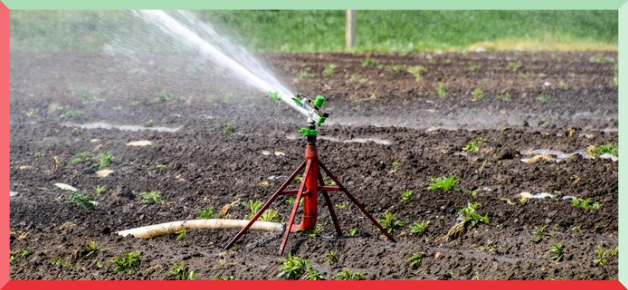
A portable sprinkler system is an efficient way to water the lawn, garden, and landscaping. This allows you to easily move the sprinklers around to target different areas, avoiding the need to install permanent in-ground systems.
Portable sprinklers come in various designs, from small oscillating or impact models to larger traveling sprinklers with wheeled bases.
Choosing the right type ensures efficient watering with minimal effort.
Types of Portable Sprinkler System
Oscillating Sprinklers
Oscillating sprinklers have a wide base and an oscillating bar with holes in which water comes out.
These sprinklers move back and forth, spraying water in a fan pattern over a rectangular area.
The high pressure created by these sprinklers makes them ideal for watering lawns and gardens.
Traveling / Wheeled Sprinkler
These sprinklers have the tractor shape following the path created by the water hose.
They have a propeller for spraying water and roll along on wheels, pulling a hose behind them as they move.
A quality traveling sprinkler allows flow adjustment and automatically turns off when it reaches the end of its run.
Impact / Impulse Sprinkler
Impact/impulse sprinklers operate by interfering water supply and stopping the water flow to create a distinctive “ticking” spray pattern.
They can cover a large area and can be set at different angles to avoid soaking your house.
Rotating Sprinkler
These sprinklers rotate as water flows through them, covering a similar area to impact sprinklers but without the noise.
This type of sprinkler emits a jet of water out in a circular motion.
Fan Sprinkler
Spinning sprinklers are also called fan sprinklers, these are often used in underground sprinkler systems.
They produce a fan-shaped spray due to obstructed flow and can be placed on stakes, similar to rotating sprinklers.
Spot Sprinkler
Spot Sprinklers do rotate without the spinning part.
They rely solely on water pressure to get their coverage, and they usually spray in whatever pattern the sprinkler has (round or square).
Bubbler
Bubbler sprinkler heads create a small water bubble or stream of water in a bubble shape to soak trees and other dedicated plants.
Since bubblers bubble water slowly and steadily prevent soil erosion and water runoff.
Benefits of Portable Sprinkler System
There are several advantages of portable sprinkler systems. Here are some of them.
Mobility
The system can be placed anywhere and, most of the time, in any landscape permit.
Portable systems can be positioned wherever needed and easily repositioned to water different parts of the yard.
Affordability
It is easy to install a portable sprinkler system. You don’t need to dig up land or bear any heavy upfront installation costs like those associated with in-ground sprinkler systems.
You can use the system anywhere on the land that requires water and move it to another place.
Customizable coverage
With a portable sprinkler system, you can focus on the land area that requires the most water. Customize and control precisely where the water goes.
Target dry spots or zones with special watering needs.
Temporary Solution
A portable sprinkler system is suitable for temporary water needs. If you are looking for a water solution for a particular season temporarily, then a portable sprinkler system is for you.
Easy Setup
You can set up portable sprinklers quickly and effortlessly.
Just connect to a spigot and position the sprinklers – no complex installation is needed.
Watering Tips for Portable Sprinkler
With a portable sprinkler system, you need to manually set up everything, so here are some tips to maximize setting up for efficient watering.
Give Water Early Morning or Evening
I’m using a portable sprinkler system for watering in the evening and sometimes at night as per my convenience.
However, it is advisable to water early in the morning or in the evening to avoid evaporation.
Adjust Runtime and Frequency
It is important to know the duration of giving water and the frequency. Dry soil requires more frequent watering, while moist soil does not need watering as often.
Adjust run times and frequency based on weather, soil type, and plant needs. Don’t overwater.
Inspect Sprinkler
When you adjust the sprinklers, be sure to inspect them properly during installation. If any debris remains in the sprinkler, it can cause clogs that affect the water distribution.
Also, ensure proper spacing between sprinklers to avoid dry spots or excessive overspray.
Use Timers
Use timers to automate watering durations, especially for larger yards.
Check Water Pressure
For optimal use of sprinkler spray distance and performance, adjust the water pressure at the spigot.
Drain and Winterize
During the winter season, make sure to drain and winterize your portable sprinklers to prevent freeze damage if they are stored over the winter.
Monitor Local Weather
Monitor your local weather forecast to temporarily suspend watering on rainy days.
Final Thoughts
A portable sprinkler system is an adaptable and cost-effective irrigation solution. With the flexibility to move and adjust sprinklers as needed, you can create a customized watering setup for your lawn or garden.
By choosing the right type of portable sprinkler and following best practices for setup and maintenance, you can efficiently maintain a lush, green landscape throughout the growing season.
Would you consider using a portable sprinkler system for your garden? Let me know your thoughts!

Leave a Reply